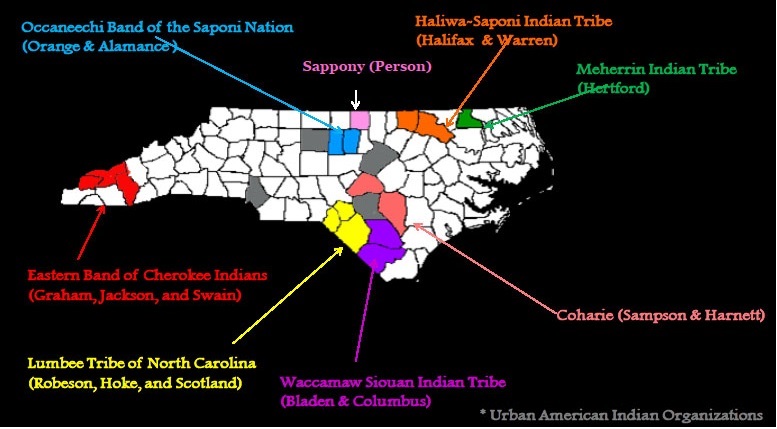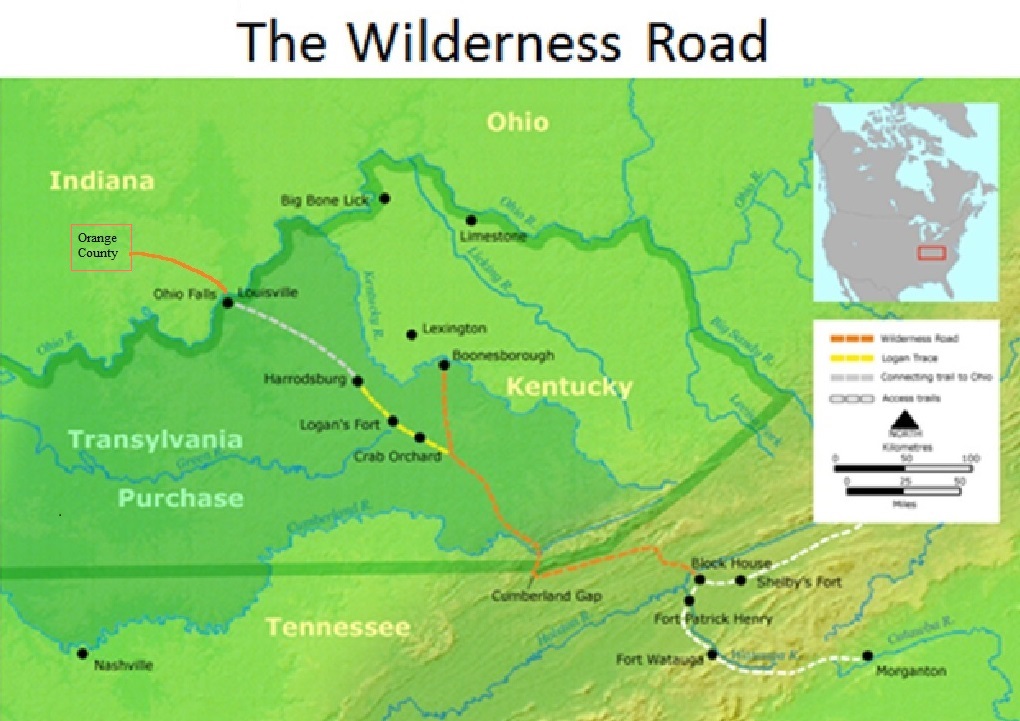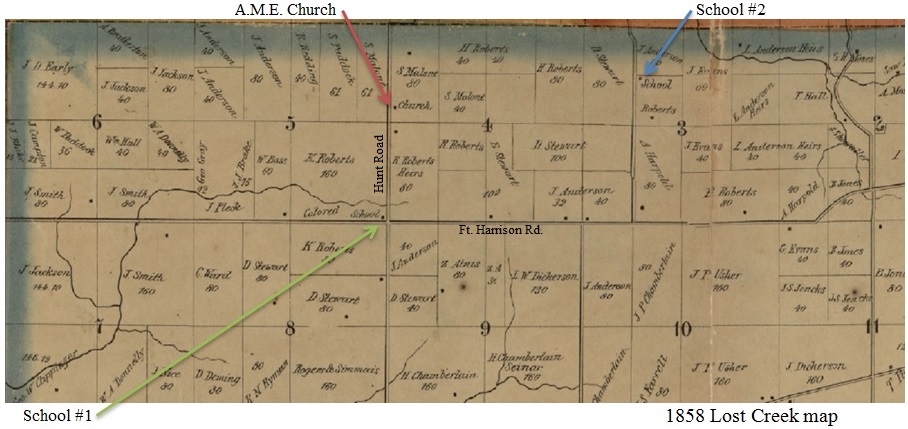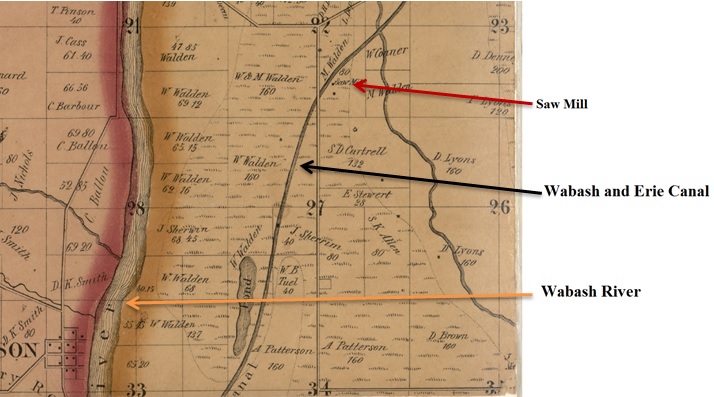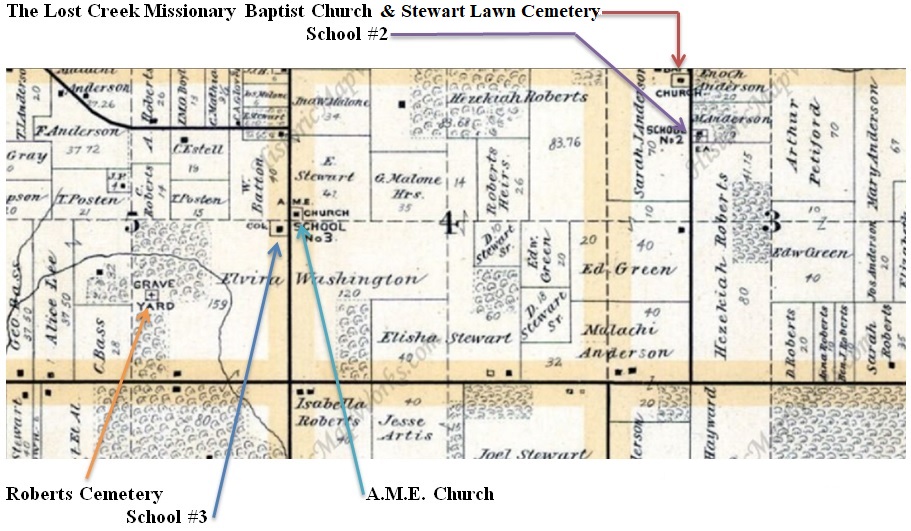Search
|
This site is in tribute to, and in honor of, our ancestors, the This site contains 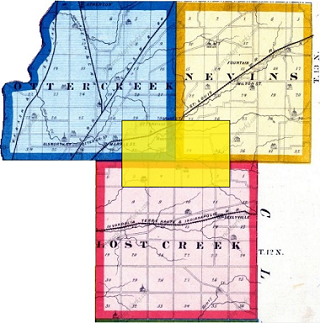
The Lost Creek Settlement - highlighted in yellow The Lost Creek Settlement was an area of approximately 20 sq. miles, or 12,800 acres, located in the Northeast corner of Vigo County. It is possible that the settlement area had been platted by a Quaker group friendly to our ancesters. Otter Creek Township was formed in 1820. Nevins Township was formed in 1822, and Lost Creek Township was formed in 1831, splitting the Lost Creek Settlement area into 3 parts, a move similar to gerrymandering. There were 25 "Free Blacks" enumerated in the 1820 Vigo County census, 11 of whom were not named, but counted in the households where they were servants. The 5 members of the Benjamin Cole family, and the 9 members of the Reese Stroud family, were technically the first "Free Blacks" enumerated in Vigo County. Armstead Stewart was born in 1783 in Dinwiddie, Virginia. He was a "free man of color" who was head of a Dinwiddie County household of 5 "other free" in 1810, and was taxable in Dinwiddie County, VA on 3 slaves in 1811, 2 slaves in 1812, and his estate was taxable on 2 slaves and 3 horses in 1813. Armstead went missing and was presumed dead. He had been kidnapped by slave trader Daniel Durham, who transported him to Vigo County, and set him free by 1822. The Free People of Color who had settled in Vigo County prior to the 1830 Vigo County census, were the families of Benjamin Cole, Joseph Artis, Jethro Bass, Isaac Beaty, Benjamin Bushnell, Joseph Patterson, Adam Riley, Armstead Stewart, and Matthew Stuart. They arrived prior to the formation of the Lost Creek Township of Vigo County. The Free People of Color who had settled in the Lost Creek Settlement prior to the 1840 Vigo County census, were the families of Abel Anderson, David Anderson, Jeremiah Anderson, John Anderson, Jordan Anderson, Lewis Anderson, Moses Archer, William Chandler, James Chavis, Edward Cooper, George Evans, Williamson Harris, Daniel Jackson, Samuel Malone, Chesley Norton, James Roberts, Kinchen Roberts, Dixon Stewart, Tazewell Stewart, Henry Trevan, Wiley Walden, and Arthur Allen, of the Underwood Settlement. The Society of Indiana Pioneers states that The Free People of Color who had settled in the Lost Creek Settlement between 1850 and 1865 Vigo County censuses, were the families of Wiley Batton, George W. Foster, Alexander Jasper, Isaac Pettiford, Daniel Poston, Aaron Powell, Dolly Ann Powell, and Abel Stewart. The Free People of Color who had settled in the Underwood Settlement between 1850 and 1865 Vigo County censuses, were the families of Arthur Allen, John Bell, Nelson Freeman, Ephraim Manuel, Wyatt Manuel, Brinkley Russell, Walden Russell, and John Underwood. Paul Heinegg's and Ancestry.com's research into the history of the colonial "free people of color" of Virginia and North Carolina, revealed several facets of American colonial history previously misrepresented by historians:
Scottish and Irish Slaves From 1641 to 1652, over 500,000 Irish were killed by the English and another 300,000 were sold as slaves. Ireland’s population fell from about 1,500,000 to 600,000 in one single decade. Families were ripped apart as the British did not allow Irish dads to take their wives and children with them across the Atlantic. This led to a helpless population of homeless women and children. Britain’s solution was to auction them off as well. During the 1650s, over 100,000 Irish children between the ages of 10 and 14 were taken from their parents and sold as slaves in the West Indies, Virginia and New England. A listing of the Irish and Scots who were shipped to the Colonies and West Indies, having surnames in common with local settlers, can be found here: Emigrants in Bondage. After the Jacobite Rebellions of 1715 and 1745, many of the captured Scottish rebels were transported from England, and sold into slavery in the colonies, and the West Indies. The passenger manifests of 10 English slave ships which sailed in 1716, have been transcribed, identifying their Jacobite slave cargo. Their wives and children were shipped seperately, and sold in the colonies and the West Indies, as well. The colonists began to breed Scottish and Irish women and girls with African men to produce slaves with a distinct complexion. These new By the law of partitus sequitur ventrem, a child born of a free mother was always free, no matter what its color or the status of its father, and many free colored people were of female Scot/Irish ancestry, and/or of female Native American ancestry. Colonial MarylandThe Maryland Colony was an English colony, settled in around 1634. The need for cheap labor led to a rapid expansion of indentured servitude, penal transportation, forcible immigration and the enslavement of Africans. Maryland received a larger felon quota than any other province. In 1692 Maryland enacted a law which punished white women who had children by slaves by selling them as servants for seven years and binding their children to serve until the age of twenty-one if they were married to the slave, and till thirty-one if they were not married. In 1715 and 1728 the Maryland General Assembly made the mixed-race descendants of white women who had children by slaves subject to the same punishments as white women. They were sold as servants for seven year terms, and their children were bound until the age of thirty-one. However, if they had a child by a free person, they were usually charged with fornication and received the same sentence as if both partners had been white: a fine or lashes, and their children were bound until the age of twenty-one (for boys) and sixteen (for girls) In colonial Maryland there were a large number of free blacks and mulattos. Maryland was a state bordering Pennsylvania, which was a free state. The laws in Maryland required the free blacks to register with the court to prove they were free, and to provide their freedom document upon demand, by any white man. Many of the free blacks chose to move to Pennsylvania to avoid this type of harassment. Slave catchers became common after years of free blacks and fugitive slaves escaping to Pennsylvania. Many slave catchers would kidnap free blacks whether they were fugitive slaves or not, and take them back to Maryland.
The Jamestown settlement in the Colony of Virginia was the first permanent English settlement in the Americas. It was established by the Virginia Company of London as "James Fort" on May 14, 1607. The settlement was located within the country of Tsenacommacah, which belonged to the Powhatan Confederacy, and specifically in that of the Paspahegh tribe. The natives initially welcomed and provided crucial provisions and support for the colonists, who were not agriculturally inclined. Relations quickly soured, and the colonists would annihilate the Paspahegh in warfare within four years. (See Bass Family History) In 1619, the first documented Africans came to Jamestown—about 50 men, women, and children aboard a Portuguese slave ship that had been captured in the West Indies and brought to the Jamestown region. They most likely worked in the tobacco fields as indentured servants. The modern conception of slavery in the United States was formalized in 1640 (the John Punch hearing) and was fully entrenched in Virginia by 1660. Relations between free blacks, mulattos and whites in colonial Virginia were very flexible at first. Free blacks, mulattos and whites often lived near one another, worked together, and socialized together. Blacks had access to the justice system and appeared to be treated equally by the courts. The colonial slaves could actually bring suit against their masters if they felt mistreated, even though free blacks and mulattos had no statutory guarantees for their rights and liberties. Some free blacks and mulattos even owned slaves and indentured servants themselves. The Bass, Chavis, Evans, Stewart, and Walden families were all slave owners in colonial Virginia. This may have been for financial reasons, or to assure their white neighbors that they were not going to assist neighboring slaves to either escape, or to rebel. At the same time, many enslaved Africans were allowed to earn money, keep livestock, and raise crops for themselves, and they sometimes took advantage of these economic privileges to purchase their own freedom. Virginia passed many laws to restrict the rights of "free people of color", which include:
The Anderson family was freed by manumission in 1712, in Virginia. They were the 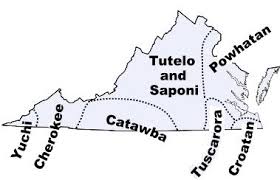
Virginia Tribal Locations Most of the Lost Creek Settlement ancestors who originated in colonial Virginia had inter-married within the local tribes. The Powhaten Federation consisted of 30 tribes, which included the Nansemond tribe, of which John Bass and Edward Bass inter-married into. Many of the Virginia, North Carolina, and Lost Creek settlers, married descendants of John and Edward Bass. The 1790 Coastal Carolina Indian Cross-Reference Database, identifies the Allen, Alvis, Gibson, Greene, Hicks, Mitchell, Patterson, and Roberts families, as all being members of the Tuscarora Tribe. Some of the free people from Virginia and North Carolina, felt more secure moving into areas where Native American tribes were located. Some of the free people married into these tribes, giving those Lost Creek settlers their Native American Ancestry.
The Lumbee Tribe was an amalgamated tribe made up of refugees from various southeastern tribes. The Lumbee’s have bio’s on most of those families, which include the Allen, Anderson, Bass, Bell, Chavis, Cheatham, Cole, Evans, Goins, Malone, Manuel, Norton, Poston, Powell, Roberts, Russell, Stewart, and Tyler families. North CarolinaThe Virginia free people relocated to North Carolina prior to the 1820’s, purchased land, and established households. In the early history of the state, the civil status of the inhabitants was largely regulated by condition rather than by color. To be a freeman meant to enjoy many of the fundamental rights of citizenship. Free men of color in North Carolina exercised the right to vote until 1835, when the constitution was amended to restrict this privilege to white men. The right of marriage between whites and free persons of color was not restricted by law until the year 1830, although social prejudice had always discouraged it. In 1786, Jonathan Lindley served in the North Carolina General Assembly at Hillsborough, also participating in the state convention that ratified the U.S. Constitution in 1788. Lindley was among the North Carolinians who insisted on amendments to the original Federal constitution, which resulted in the Bill of Rights. As a Quaker with anti-slavery convictions, Lindley introduced several bills to curb slavery, one of which called for an end to the importation of slaves from Africa to North Carolina, a crucial first step toward abolition. The slave trade in North Carolina was outlawed in 1794, partly through Lindley's efforts, though slavery itself survived until the Civil War. Lindley left the General Assembly in 1805. Lindley and his son Zachariah traveled overland to Indiana Territory in 1808 to prospect for land. The Exodus to IndianaFor a variety of reasons, the decision to move north was made. Those reasons included the Indian Removal Act of 1830, and the retaliation for an insurrection in 1831 led by Nat Turner where the state executed 56 blacks and militias killed at least another 100 blacks. Free blacks arrested in Southampton County after Nat Turner's Rebellion included Arnold Artist (Artis), Exum Artes, Berry Newsom, Thomas Haithcock, and Isham Turner. Artes, Haithcock, and Newsom were sent for further trial. The Lost Creek and Underwood settlements would become the new sanctuary areas. To get to Indiana from North Carolina, the migrants had to travel thru the Appalachian Mountains. Daniel Boone had carved out a trail thru the mountains from North Carolina thru Kentucky, which became known as the Wilderness Road.
In 1811, Jonathan Lindley, an Irish-born Quaker, led a wagon train of emigrants from his section of Orange County, North Carolina to the Lick Creek watershed in the southern part of the Indiana Territory. According to one Lindley tradition, two hundred people went to Indiana in this caravan. A Quaker history indicates that seventy-five of them were members of the Society of Friends. Quaker records further reveal that more than thirty of the emigrants were close relatives of Lindley and that eleven of them were his children, some married and with their own families. Eleven families of "free people of color" were also a part of the caravan. Traveling with the Quakers offered some protection on their journey and the promise of supportive neighbors upon their arrival. Jonathan Lindley's oldest son, Zacharias, had settled in Lick Creek Valley two years before the arrival of the great Lindley caravan. Two years before leaving North Carolina, Jonathan had made a prospecting trip to Indiana and had purchased a large tract of land where Terre Haute now stands, but Indian discontent in that region caused this large caravan of emigrants to stop in the southern part of the territory. In 1816, Lindley was still the largest stockholder in Abraham Markle's "Terre Haute Company," which platted the town in 1821. Some sources cite him as a founder of Terre Haute. The Lick Creek Settlement of Orange County, Indiana 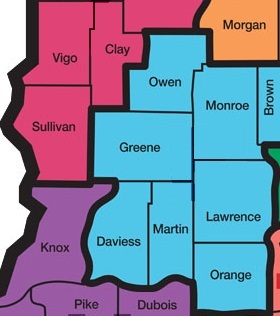
Southwest Indiana Counties The Quakers established the Lick Creek Settlement, in Orange County, where arriving black settlers, were welcomed and assisted. Sometime after 1820, the Anderson, Archer, Burnett, Chavis, Jasper, Roberts, Scott, Thomas, and Trevan families, settled there. They were classified as Family surnames in the county include Bass, Burnett, Finley, Isom, Larter, Pettiford, Roberts and Walden. Arthur Larter and his family are in the North Carolina census in 1850 and Perry Township, Lawrence County, Indiana in 1860. According to the Lawrence County abstract records for Perry Township, the family owned land in 1865. Information gleaned from the Recorder’s office shows the Larter family buying and selling land in 1864. Jennings Larter’s son, Leason, is born in Indiana in 1856, and Milton Larter’s daughter, Amanda, is born in Indiana in 1853, so it appears the family migrated sometime during the early 1850s. Arthur Larter's daughter Elizabeth, married George Russell, and daughter Mary Ann married Isaac Pettiford, both while still in North Carolina. Other daughters married into the Lost Creek settlement families of Powell, and Roberts, and sons married into the families of Harris, and Hill. One of the Bass family members born in Mitchell, Indiana was Samuel Bass. He went on to become known as "Sam Bass - the Outlaw". He was one of the Old Wild West's famous bank and train robbers, who was eventually shot and killed by Texas Rangers. Dixon Stewart was 1 of 70 black settlers listed in the 1830 Monroe County census. Dixon was the head of a household of 2. Dixon's brother Evan was head of a household of 8. Two houses over from Dixon and Evan, was the family of James Roberts, son of Ishmael, who was head of a household of 11. They had settled in Monroe County, Indiana in 1827. Dixon married Lucinda Roberts, daughter of Kinchen 24 Jan 1830, in Monroe County, where they had son Elisha on 16 Nov 1830. Washington Township was one of the original townships, dating back to the county's formation. The families of Eaton Walden, Jarrel Walden, and Boin (Bowen) Roberts, all from North Carolina, were the first black settlers in Washington Township, arriving before 1825. Richard Walden, son of Eaton, donated land in 1842 for the Walden Cemetery. Richard sold Lots no. 105 and 109 in November 1826 to Boin Roberts. Boin (pronounced Bowen), may have been one of the first Roberts to migrate to Indiana. Land records show that he bought several plots of land in Owen County, near the city of Spencer, in as early as 1825. Probate Court records show that he returned to Chatham County, NC in February 1830, to settle property claims with his family, after the death of his father, Ishmael Roberts. Before travelling back to Owen County, he obtained "free papers" in Chatham County on 1 March 1830 and recorded them in Owen County on 31 October 1831. The 1830 US Census for Indiana shows Bowen living in Owen County, from where he migrated to Lawrence County before 1850. Other families who settled in Owen County were Bass, Boone, Evans, Goss, Harris, Larter, Mitchell, Pettiford, Powell, and Russell. By 1850, Marion Township's colored population was on the decline, after the Bass, Harris, Russell and Powell families all left for Vigo County. During the territorial period, and after statehood, Indiana discouraged the immigration of free blacks with laws requiring them to prove their freedom, register with local authorities, and provide sureties for their good behavior and economic independence by posting a $500 bond. In an effort to further limit black immigration, in 1831 the state provided that blacks who failed to comply with these laws could be hired out for six months or be expelled from the county. Edward Cooper, a free black, had moved to Vigo County after the passage of the 1831 law, but had failed to register under the law. A justice of the peace ordered that he be hired out, but the circuit court reversed this order, asserting that the 1831 law violated the state constitution's ban on involuntary servitude. Cooper was freed, but the State Supreme Court overturned the ruling. Thus, Cooper was placed in "involuntary servitude" without breaking any laws, costing the county any money, or threatening anyone. He had not sought public welfare, but he had not found people to vouch for him and guarantee that he would never become poor or that he would never be convicted of a crime. Anderson family members started migrating from the Lick Creek Settlement in Orange County, Indiana to Lost Creek, in around 1832. They were Able Anderson, David Anderson, Jordan Anderson, Jeremiah Anderson, and Lewis Anderson. Roberts family members started migrating from Orange and Monroe Counties in Indiana, to Lost Creek, in 1832 as well. They were Kinchen Roberts, his brother James, brothers-in-law Moses Archer and Henry Trevan, and son-in-law, Dixon Stewart. The Underwood SettlementThe Underwood Settlement was the other Both, the Lost Creek and the Underwood Settlements were "tri-racial isolate" communities, a mix of Native American, European, and African. Up until about 1930, they were largely endogamous, that is, marrying primarily within the two settlement communities. Indiana - Almost a Free State [4]When Indiana achieved statehood in 1816, its state Constitution contained language similar to Article 6 of the Northwest Ordinance of 1787—no new enslaved people were allowed, but currently enslaved individuals remained so. So, by 1816, Indiana was a free state, but it was not a state friendly to black people. In Indiana, blacks were denied a free public education, and could not legally attend public schools with whites even if they paid tuition and no white parents of school children objected to their presence in the school. As the Indiana Supreme Court noted in its subsequent interpretation of the 1816 constitution, "black children were deemed unfit associates of whites, as school companions." The Lost Creek Community built and supported it's own schools and churches. The first school in the Lost Creek Settlement was built in 1835, on an acre of ground donated by Kinchen Roberts at the intersection of Ft. Harrison and Hunt roads. The first teachers were Abel Anderson and Aaron Smith. There were a total of 3 district schools in the Lost Creek Settlement, with school #3 still in operation up until 1961, when Vigo County consolidated all of the county schools. In 1839, Jethro Bass helped to establish the Lost Creek A. M. E. Church, located on Hunt Road, where he served as one of its pastors. In the same year, Nelson Bass, Jethro Bass, Nancy Bass, Juda Florence, and Mary E. Johnson, met to organize the Allen Chapel A.M.E. Church in the city of Terre Haute.
Indiana's 1851 constitution, put the Hoosier state in the unique position of banning both slavery and free blacks, while still allowing visiting masters to enter the state with their slaves, and still allowing for poor blacks or those without the proper papers to be hired out against their will. Article XIII of the Indiana Constitution of 1851, stated that:
Additional legislation required all blacks already living in Indiana to register with the clerk of the circuit court. The list of those residents from Vigo County who registered can be found here. Abolitionists who opposed the new constitution, devised a network of safe houses, and tunnels, to ferry new migrants north, across Indiana, into Michigan and Canada. In Vigo County, Markle’s Mill, the Allen Chapel in Terre Haute, and the A. M. E. Church in Lost Creek were all used as part of Indiana’s leg of the Underground Railroad. The Lost Creek A.M.E. Church was destroyed by a fire in 1949, and was never rebuilt. A monument commemorating the church’s roll in the Underground Railroad, now stands in the SW corner of the church property. 
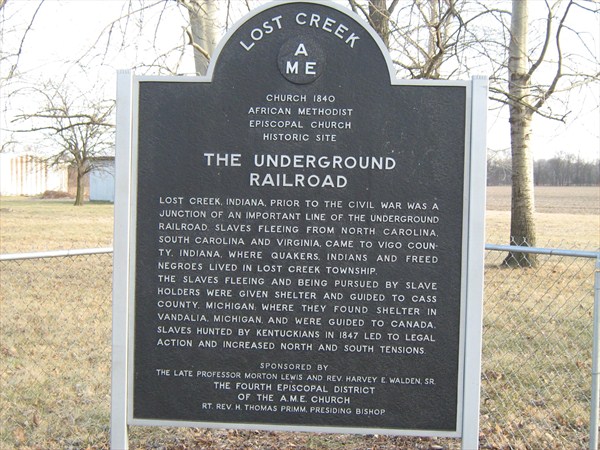
During the 1850’s, Wiley Walden and son Milton, owned about 1,100 acres, in Otter Creek Township, between the Wabash River and the Wabash and Erie Canal. There was a saw mill located on Milton’s property, next to the canal, where harvested trees were sawed into lumber, and sold across the state. The canal was used to transport material from Toledo, Ohio, on Lake Erie, to Evansville, Indiana, on the Ohio River.
The Roberts Cemetery Kinchen Roberts owned 280 acres at the intersection of Hunt Road and Fort Harrison Road. In 1832, Kinchen’s son Banister, was the first to die in Lost Creek, and was buried on Kinchen’s property. In 1870, Kinchen’s son Reden, set aside 1½ acres of land, where his brother Banister and other pioneer family members were buried, for use as a community cemetery. This cemetery was commonly known as the The cemetery was not subdivided off from the rest of Reden Roberts property, so after his death, and the subsequent death of his widow in 1928, the land was sold, and access to the cemetery was restricted by the new property owners. The cemetery was closed in 1929. The only recorded burial in the cemetery after it was closed, was that of Jemima Stewart Smith, in 1941. Her death certificate lists the place of burial as the "Sheppard Cemetery" [sic]. The Shepard property was sold in 1947, and the new land owners allowed their cattle to graze in the cemetery. The cattle displaced and/or destroyed many of the tombstones. In 1991, the current owners of what was the "Roberts" property, subdivided the cemetery off from the rest of the property. A fence was erected around the cemetery in 1993, and the cemetery was officially named the Roberts Cemetery, in commemoration of Reden Roberts. The Stewart Lawn CemeterySeeing the need for an additional cemetery, community leaders, Paul Anderson, Matthew Hathecock, George Shepard Sr., and Zachariah Stewart donated funds to purchase 1 acre of land, north of, and adjacent to the Lost Creek Baptist Church, from Dixon Stewart Jr., in 1925. Additionally, Dixon Stewart Jr. graciously donated a second acre for the cemetery, and in 1945 an additional acre was purchased. The cemetery was named the In 2017, the cemetery land title still bears the name of the
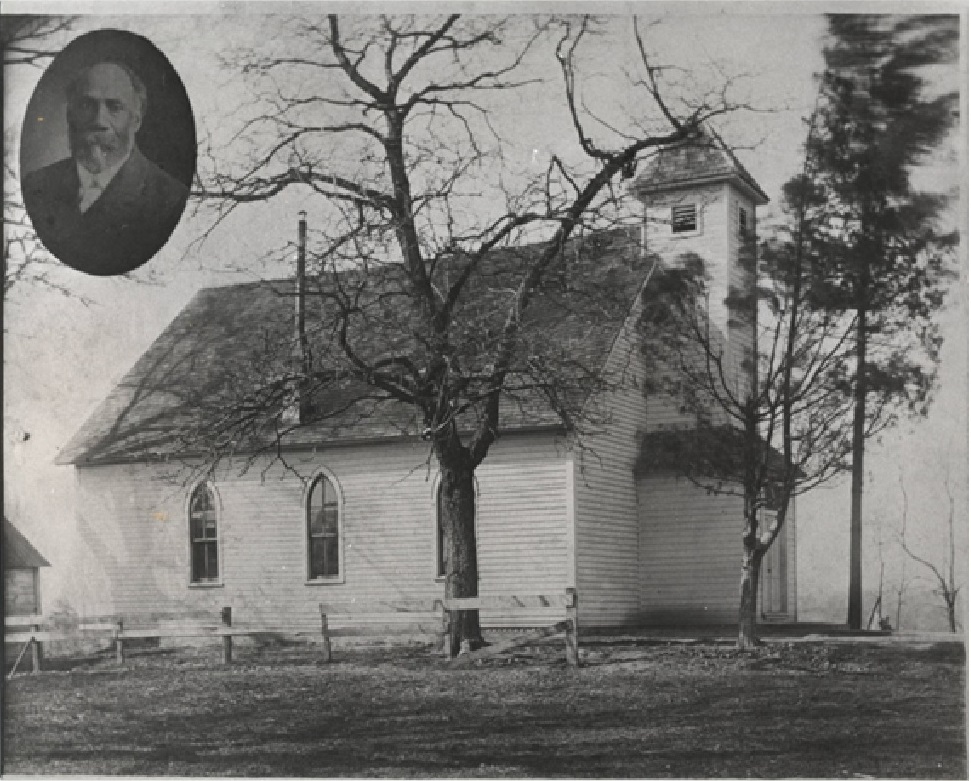
Lost Creek Baptist Church circa 1900 The Lost Creek Missionary Baptist Church was built in 1850. A fire destroyed the church in 1868, and it was rebuilt in 1869. The church is located on Creel Road in eastern Vigo County. Rev. Lewis Artis served as pastor from 1850 to 1872. He was followed by Rev. William H. Anderson from 1872 to 1874, and Rev. George Anderson from 1874 to 1879, followed by Malachi Anderson, shown in the inset. The church had a sizable membership from the Burnett community. Burnett was a coal mining community, north of Lost Creek, in Otter Creek Township. Post Civil War emancipated slaves, came to Burnett, and other surrounding communities, to find work. The church helped to bring the two communities together, by the mid 1900's. 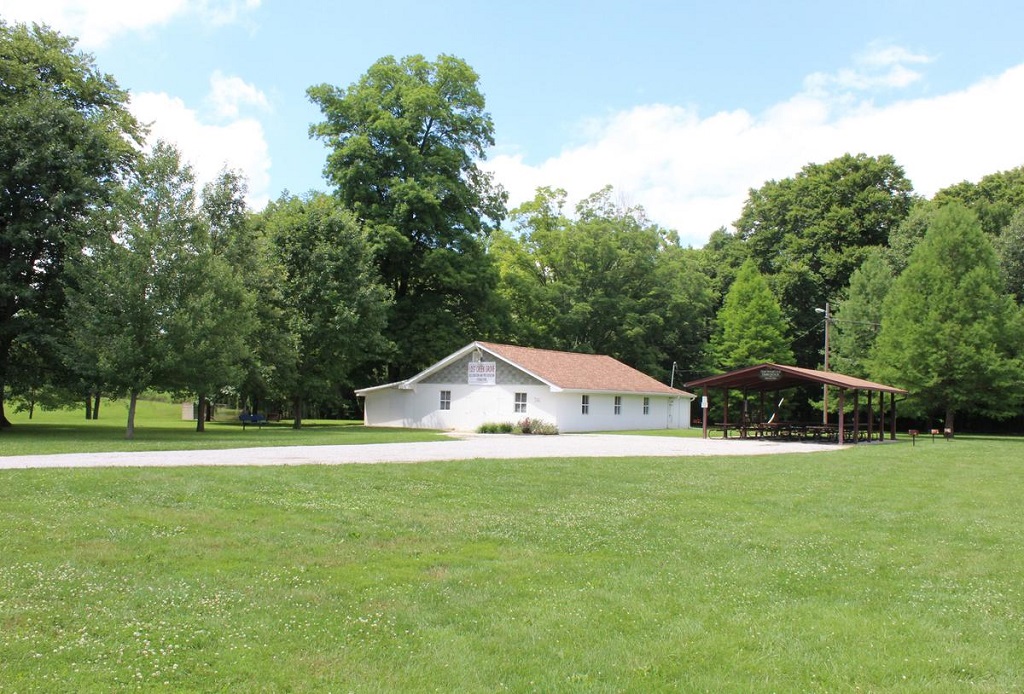
Lost Creek Community Grove Following the dedication of the new District No. 3 School building on December 2, 1945, the young people in attendance met and organized the Lost Creek Community Club for the purpose of providing wholesome recreation for the area. Officers elected included: Cleta Harris, President; Felix Shepard, Vice-President; Nola Shepard, Treasurer; Dorothy Ross, secretary; Walter Edwards and Bert Ross, Trustees. On April 5, 1946, the officers and trustees met with Nathaniel Tootle concerning the purchase of “The Hamilton Grove.” On June 9, 1946 a meeting was held at the home of Walter and Beulah Ross Edwards to decide upon the name of the newly acquired property. It was renamed the “Lost Creek Community Grove.” The original owner of the property was Sam Malone, whose daughter Elizabeth married Elisha Stewart, who in turn gave the land to their daughter, Mary A. Stewart on March 2, 1901. The six and one-half acre plot of land was purchased from Nathaniel Tootle, the widower of Mary A. Stewart Hamilton Tootle on November 16, 1946, for $500. The Warranty Deed lists Walter Edwards, Verdell Hathecock and Maynard Shepard as Trustees. Only 6 relics remain today to serve as memorials to the Lost Creek Settlement. They are the Lost Creek Community Grove, the Lost Creek Missionary Baptist Church, the A.M.E. Church Memorial, the Russell Cemetery, the Roberts Cemetery, and the Stewart Cemetery in Otter Creek Twp. The Lost Creek Missionary Baptist Church now has a congregation of only 8 to 10 members.. It is still used for funeral services, and as a meeting place for family memorials. The Lost Creek Community Grove is used for family re-unions and other community events. The Roberts Cemetery and the Stewart Cemetery are inactive. The Russell Cemetery is used for Russell family members only. Today, there are only 7 households in the Lost Creek Settlement, that are occupied by descendants of the original settlers. References1. The Irish Slave Trade – The Forgotten “White” Slaves 2. Convict Voyages |
|||||||||



